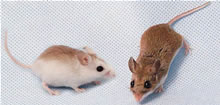Interaction of Two Genes Governs Coloration Patterns in Mice
AUGUST 13, 2007
By Steve Bradt and Kim McDonald

Camouflaged beach mouse forages on the coastal sand dunes in Florida.
Credit: JB Miller
Biologists at Harvard University and the University of California, San Diego have found that a simple interaction between just two genes determines the patterns of fur coloration that camouflage mice against their background, protecting them from many predators.
Their discovery, detailed this week in the journal PLoS Biology, marks one of the few instances in which specific genetic changes have been linked to an organism's ability to survive in the wild.
"Our work shows how changes in just a few genes can greatly alter an organism's appearance," says Hopi E. Hoekstra, an associate professor of natural sciences at Harvard University. "It also illuminates the pathway by which these two genes interact to produce distinctive coloration. There's reason to believe this simple pathway may be evolutionarily conserved across mammals that display lighter bellies and darker backs, from mice to tuxedo cats to German Shepherds."
Hoekstra and co-authors Cynthia C. Steiner at UCSD and Jesse Weber at Harvard studied Peromyscus, a mouse that is the most widespread mammal in North America. Within the last several thousand years, these mice have migrated from mainland Florida to barrier islands and dunes along the Atlantic and Gulf coasts, where they now live on white sand beaches. In the process, the beach mice's coats have become markedly lighter than that of their mainland brethren.

Light fur evolved to help beach mice survive on white sand dunes, while darker fur help mainland mice survive in fields.
Credit: Peromyscus Genetic Stock Center
"In nature, there is a tremendous amount of variation in color patterns among organisms, ranging from leopard spots to zebra stripes, that help individuals survive," says Steiner, a postdoctoral researcher in UCSD's Division of Biological Sciences. "However, we know surprisingly little about how these adaptive color patterns are generated. In this paper, we identify the genetic changes producing a simple color pattern that helps camouflage mice inhabiting the sandy dunes of Florida's Gulf and Atlantic coasts. These 'beach mice' have evolved a lighter pigmentation than their mainland relatives, a coloration that helps camouflage them from predators that include owls, herons, and hawks."
Previous research has shown that such predators, all of which hunt by sight, will preferentially catch darker mice on the white sand beaches, providing a powerful opportunity for natural selection to evolve increased camouflage.
Through a detailed genomic analysis, Hoekstra, Steiner and Weber identified two pigmentation genes, for the melanocortin-1 receptor (Mc1r) and an agouti signaling protein (Agouti) that binds to this receptor and turns it off. A single amino-acid mutation in Mc1r gene can weaken the receptor's activity, or a mutation in the Agouti gene can increase the amount of protein present without changing the protein's sequence, also reducing Mc1r activity and yielding lighter pigmentation.

Camouflaged beach mouse forages on the coastal sand dunes in Florida.
Credit: Robert Burks
Both genes affect the type and amount of melanin in individual hairs. When both genes are turned on, the mouse is dark in color. A mutation that changes either gene leads to a somewhat blonder mouse, but it is the combination of mutations in both genes that produces a mouse very light in color.
"Thus, two different types of mutations in two different genes each contribute to the light coloration of beach mice," Hoekstra says. "This work represents a first step into understanding how unique patterns of fur color are produced via a simple interaction between genes."
Hoekstra, Steiner and Weber's work was funded by the National Science Foundation and the National Institutes of Health.
